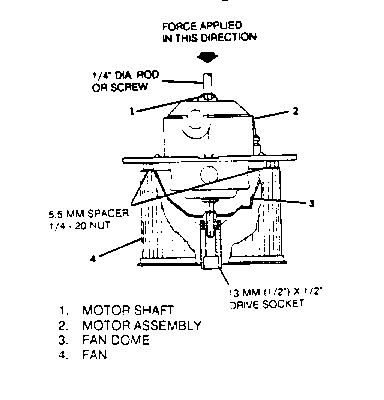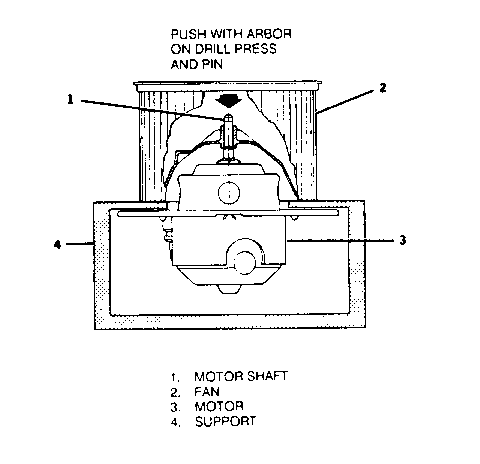SERVICE MANUAL UPDATE SEC. 1A-1B PUSH ON BLOWER FAN

SUBJECT: SERVICE MANUAL UPDATE-SEC 1 A-1 B HEATER/AC - REVISED SERVICE PROCEDURE - PUSH-ON BLOWER MOTORFAN
MODELS/YEARS: 1991 CUTLASS CALAIS
This bulletin revises heater and A/C blower motor removal/replacement procedures and instructions on servicing the new push-on fan assembly.
Please mark a reference to this bulletin in your copy(s) of the 1991 Cutlass Calais service manual, pages 1 A-1 1 and 1 B-47.
BLOWER MOTOR AND FAN ASSEMBLY
2.3L and 3.3L Engine
Remove or Disconnect:
1. Negative battery cable 2. Electrical connections at blower motor 3. Blower motor cooling tube 4. Blower motor retaining screws 5. Blower motor fan * Refer to "BLOWER MOTOR FAN REPLACEMENT"
Install:
1. Blower motor assembly 2. Retaining screws 3. Blower motor cooling tube 4. Electrical connections 5. Negative battery cable
2.5L Engine
Remove or Disconnect:
1. Negative battery cable 2. Power steering upper bolt and pivot bolt 3. Loosen lower adjusting bolt 4. Position pump assembly away from blower motor 5. Electrical connections at blower motor 6. Blower motor cooling tube 7. Blower motor retaining screws and blower motor assembly 8. Blower motor fan * Refer to "BLOWER MOTOR FAN REPLACEMENT"
Install:
1. Blower motor assembly 2. Retaining screws 3. Blower motor cooling tube 4. Electrical connectors 5. Reposition power steering pump 6. Pivot and upper power steering pump bolts 7. Adjust belt and bolts to proper tension * Refer to Maintenance and Lubrication (Section OB) 8. Negative battery cable
BLOWER MOTOR FAN REPLACEMENT
I. Remove Fan
- Use heat knife or soldering iron.
- Cut material on shaft axially in three places: Starting 1/2" from base of fan shaft, start cut into fan dome and continue to cut through the plastic material to the end of shaft so that the fan splits from the shaft.
- Grasp fan and pull off the shaft.
NOTICE: Do not hammer motor or place heavy "side way" impact on fan or motor damage may occur.
IA. Alternate Methods To Remove Fan
- Use small wheel or gear puller.
- Remove tip of fan, if necessary, at end of motor shaft using soldering iron or end cutting pliers, vise grip pliers or Channelock's pliers.
- Draw fan from motor shaft using a small puller. Hook legs of puller between fan lower rim and motor mounting plate. Thread center post of puller against the end of the motor shaft exposed in the above step.
- Use drill press or small arbor press.
- Remove tip of fan, if necessary, at end of motor shaft using soldering iron or end cutting pliers, vise grip pliers or Channelock pliers.
- Support fan as shown in Figure 1, with blocks, angle iron, etc., while allowing the motor to be suspended as shown. Place steady pressure on tip of motor shaft as shown, with a drill press or small arbor press and pin arrangement. Motor should fall freely from the fan after moving motor shaft about 1/2 inch.
NOTICE: Do not hammer motor or place heavy "side way" impact on fan or motor damage may occur.
II. Fan Installation
- Insert fan on motor shaft.
- Grasp fan by dome and by applying hand pressure to fan dome insert fan on motor shaft until fan is lightly seated on motor shaft.
- Place fan and motor on a 13mm (1 /2") x 1/2" drive socket as shown in Figure 2.
- While steadying the fan and motor, apply steady force to the rear of the motor shaft, using a drill press or small arbor press and pin arrangement, until the clearance between the motor mounting plate and the fan hub is 5.5 mm + /- 0.5 mm. A 1/4" - 20 nut is approximately 5.5 mm and can be used as a spacer as shown in Figure 2.
- Remove the spacers (nuts) by grasping fan dome and turn fan which will dislodge spacers from under fan.
NOTICE: Do not hammer on motor to install fan or damage to motor may occur.
- To prevent motor shaft/bearing damage, do not apply force to motor housing to seat fan on motor.
- To prevent fan damage during installation, do not apply pressure to fan rim.
- It is necessary to ensure the proper replacement fan is used.
- Seal end housing of blower motor using "water resistant" tape (provided in motor kit).
WARRANTY INFORMATION
Labor Operation Number: D 1 322 with A/C D 1 320 without A/C
Labor Time: with 3.3L Engine 0.4 hour with 2.3L Engine 0.4 hour with 2.5L Engine 0.5 hour
Trouble Code: 92


General Motors bulletins are intended for use by professional technicians, not a "do-it-yourselfer". They are written to inform those technicians of conditions that may occur on some vehicles, or to provide information that could assist in the proper service of a vehicle. Properly trained technicians have the equipment, tools, safety instructions and know-how to do a job properly and safely. If a condition is described, do not assume that the bulletin applies to your vehicle, or that your vehicle will have that condition. See a General Motors dealer servicing your brand of General Motors vehicle for information on whether your vehicle may benefit from the information.
